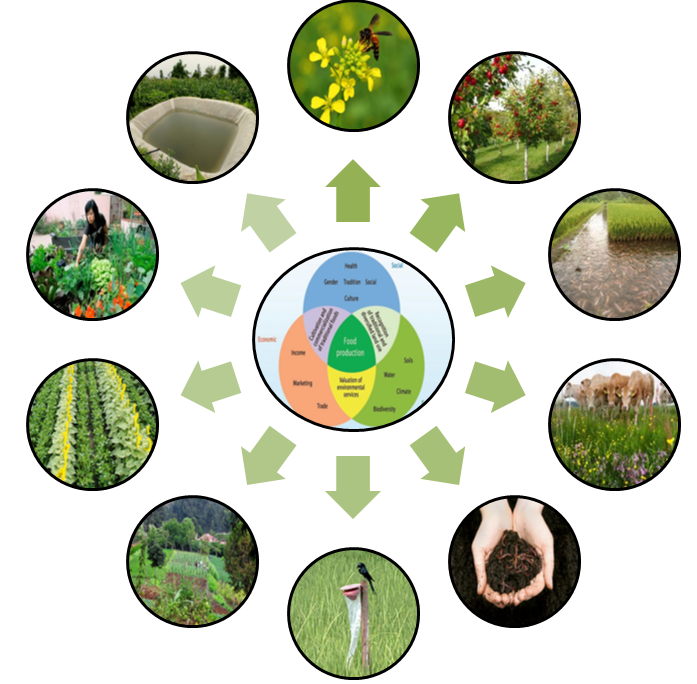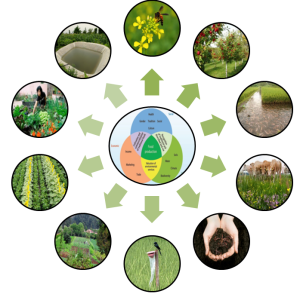Agroecology—the desired agriculture environment
15 Ways to implement agroecology
Have you ever thought of what our life is bound with. Aren’t we surrounded by trees, bushes, flowers, and fruits? Think of all the moving species –the ants, flies, bees and the multi-colored butterflies. The cats and dogs that adorn our house as friends and as children are no less important. And if you are living in the farm, you are the luckiest creature on earth. The milking cows, poultry birds, fish from the pond all make your life a luxury. To go further into what provides us life and livelihood is agroecology. This is the environment, the combined production that maintains your life is agriculture.
What is agriculture?
Agriculture is simply the art and science of farming. From ancient times humans grew crops in soils, raised animals, took care of forests that provided not only food, clothing, medicine and shelter but a means of livelihood through sale and marketing. Introduced practices in agriculture molds the environment to the specific needs changes in the environment leads to an impact on the ecosystem.
Our Environment
The living environment is a combination of a set of organisms, which offer surroundings for change and growth of living and other natural forces. Here we are more concerned of the environment that helps make our surroundings livable and productive without causing harm to human health or animals
What is then agroecology?
Agro means agriculture. Ecology is the systematic study of interfaces of organisms with the physical and living environment. In other words ecology is the external factors i.e. the air, soil, plants, minerals, water that affect a place at a certain time. Agroecology is the study of ecological processes that operate in agricultural production structures. Agroecology proposes to practice the use of resources of the environment in a holistic way to get maximum benefit without disturbing the natural ecosystem and therefore ecology denotes any practice of biodiversity or the harmonious abode of a variety of animals and plants. Agroecology does not encourage the addition of substitutes but, in fact, restructures integral and innovative use of natural resources to maximize gain. The ecological elements are not associated with any one specific process of farming, conventional, integrated, organic, intensive or extensive. It uses ecological functions to resolve environmental, sustainability and production goals. In addition, Agroecology blends indigenous information with modern knowledge to reach an environmentally favorable and socially accepted approach to agriculture, taking into consideration social equity, environmental sustainability with a prime objective of reaching the production target.
Agroecology studies agricultural systems from an ecological and socioeconomic perspective. It is also considered the scientific foundation of sustainable agriculture. It provides natural concepts and principles to analyze, build strategy and manage of productive, resource-conserving agricultural systems. Conversely, orthodox agronomic practices that focus on the spread of packaged uniform technologies, agroecology emphasizes on vital principles such as biodiversity, recycling of nutrients, synergy and interaction among soil, crops and animals and revival and protection of resources. The particular methods or technologies promoted by agro-ecologists build upon local skills and are adapted to local agroecological and socioeconomic conditions. The implementation of unique values of agroecology in the context of pro-poor, farmer-centered rural development objectives is indispensable for equitable, sustainable and productive systems.
Challenges of agroecology
A key challenge of applying agroecology is to comprehensibly understand manifold relationships and feedbacks across two broad cross-disciplinary limitations that go outside conventional viewpoints on agricultural, environmental, and social sciences. Within this larger definition of agroecology, society, and its various aspects play fundamental roles, shaping agriculture to produce the multifarious food requirements.
What is an agroecosystem?
An agroecosystem is the fundamental unit of agroecology. It combines the living and non-living components as to their existence and interactions or existence of a biological community in a physical setting. The agroecosystem is a management process. The ecosystem is made up of single-celled organisms (bacteria, fungi) to complex plants, animals, people, air, water, nutrients, solar energy and most importantly the soil.
The ecosystem in reality cycles nutrients from the humans and animals back to the environment. In the environment, the wastes are decomposed nutrients. The nutrients remain in the soil. The essential nutrients are absorbed by plants to produce vegetation and food. In this cycling process, some nutrients leak out as runoff. In a well-managed and sustainable ecosystem, the loss is minimal as most nutrients are recycled and reused. This is what modern day agriculture calls for. The agricultural or agroecosystem is a replica of a natural ecosystem where management is concentrated for food and fiber for human consumption. Further, as it combines plants, animals and forest species the approach looks forward to not only food security but to the nutritional security of the population. the development of agricultural ecosystems intended to be sustainable and self-sufficient.
Our concern
Presently, hunger and malnutrition exists in 800 million people of the developing world.
A few reasons are
- Insufficient production
- Inadequate intake of the right or balanced food
- Unequal distribution of food
- Absence of sustained productivity
- Unable to use the productive per unit of space.
- Low purchasing power of nutritious food.
Agroecology—future of farming
Scientists and environmentalists now believe that sustained farming and safe food depends on the use of the concept of agroecology or alternative method of farming. As there is an innumerable school of thoughts in favor and in against using the full potential of agroecology, some major points will create awareness on how food producers can bring about a second “green revolution”.
The basic philosophy of agroecology comprise of recycling of nutrients and energy on the farm, mixing crops and livestock; diversifying species and genetic resources over periods of time, space and concentrating on interactions and productivity across the agricultural system, rather than focusing on kinds. Agroecology is greatly knowledge-intensive, based on techniques that are not delivered top-down but established on the basis of individual or participatory farmers’ knowledge and research. It is the desired agriculture environment that will lead to food and nutritional security without harming the environment.
These experiences of France and many other countries demonstrate the feasibility of intensifying production, retention of soil structure, and conserving biodiversity, based on a holistic approach of all agro-ecological components and resources. Cases studies show that when correctly managed, agroecological systems.
- sustain a more stable although a lower level of production per unit area and over time.
- the returns depict a favorable cost-benefit returns
- assure small farmers with small holdings a better livelihood
- improve agro-biodiversity by conserving and protecting soil fertility
- Brings in biodiversity in food intake
What to expect?
Agroecology is a transitional process to replace chemical and high technological methods of farming. It integrates ecosystem principles with the diversification of cover crops, no-tillage, livestock, poultry, agroforestry, allopathic plants, bio fertilizer, biological control fitting to the specific macro and microclimatic regimes.
In addition, the success of agroecology would depend on participatory, farmer-friendly methods of technology development to suit specific environments. Incorporation of appropriate technology to reduce the drudgery of women, men, elders, and marginalized poor farmers or labor groups should be considered in adopting alternative methods. Additionally diverse food availability will ensure a balance in requirement as well as nutritional security.
How to implement?
Although alternative methods of farming supplies than 3% of the food, many of the agroecological principles are either singly or with a few combinations. A whole farm or holistic approach to the application of agroecology could take us further on alternative farming for food and nutritional security.
15 Ways to implement agroecology
- Diversified cropping-multiple cropping or intercropping
- Diversified crop rotation
- Relay cropping
- Multistoried cropping
- Integration of fruit, timber, and medicinal crops
- Landscape and cow breed
- Grassland and goat
- No-tillage or strip tillage
- Duck and fish culture
- Rice and fish culture
- Introduction of biofertilizer use
- Introduction of biopesticide
- Use of river banks, forest edges
- Harboring beneficial insects
- Drip irrigation and conservation of rain water
The environment of agriculture needs focus on a different perspective for agroecology to express its full potential. Hunger due to deprivation quality food intake can be addressed with the intensification of agroecology. The growth of the principles of agroecology is still at the seedling stage. So, its full benefits to health and environment to yet to be seen. However much, lies on the education and awareness to apply the principles and materialize the prospects for our health and happiness.









No Comments